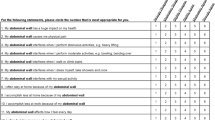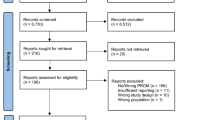Abstract
Background
Current hernia patient-reported outcome (PRO) measures were developed without patient input, greatly impairing their content validity.
Objective
The purpose of this study was to develop a conceptual model for PRO measures for ventral hernia (VH) patients.
Methods
Fifteen semi-structured, concept elicitation interviews and two focus groups employing nominal group technique were conducted with VH patients. Patients were recruited between November 2015 and July 2016 over the telephone from a five-surgeon patient cohort at our institution. Iterative thematic analysis identified domains. Reliability and validation were achieved using inter-rater reliability checks and triangulation.
Results
Seven framework domains were established: (1) expectations; (2) self and others; (3) surgeon and surgical team; (4) sensation; (5) function; (6) appearance; and (7) overall satisfaction. Overall patient satisfaction was associated with two themes: (1) provider–patient relationship; and (2) patient assessment of post-repair improvement.
Conclusions
VH patients experience a profoundly broad range of reactions to VH repair. A patient-informed PRO instrument that addresses the spectrum of patient-identified outcomes can guide practice, optimizing care targeting VH patients’ needs.


Similar content being viewed by others
References
Colavita PD, Tsirline VB, Walters AL, Lincourt AE, Belyansky I, Heniford BT. Laparoscopic versus open hernia repair: outcomes and sociodemographic utilization results from the nationwide inpatient sample. Surg Endosc. 2013;27:109–17.
Poulose BK, Shelton J, Phillips S, et al. Epidemiology and cost of ventral hernia repair: making the case for hernia research. Hernia. 2012;16:179–83.
Van Ramshorst GH, Eker HH, Hop WCJ, Jeekel J, Lange JF. Impact of incisional hernia on health-related quality of life and body image: a prospective cohort study. Am J Surg. 2012;204:144–50.
Holihan JL, Alawadi Z, Martindale RG, et al. Adverse events after ventral hernia repair: the vicious cycle of complications. J Am Coll Surg. 2015;221:478–85.
Klassen AF, Cano SJ, Schwitzer JA, et al. Development and psychometric validation of the FACE-Q skin, lips, and facial rhytids appearance scales and adverse effects checklists for cosmetic procedures. JAMA Dermatol. 2016;152:443–51.
Pusic AL, Klassen AF, Scott AM, Klok JA, Cordeiro PG, Cano SJ. Development of a new patient-reported outcome measure for breast surgery: the BREAST-Q. Plast Reconstr Surg. 2009;124:345–53.
Eypasch E, Williams JI, Wood-Dauphinee S, et al. Gastrointestinal Quality of Life Index: development, validation and application of a new instrument. Br J Surg. 1995;82:216–22.
Heniford BT, Walters AL, Lincourt AE, Novitsky YW, Hope WW, Kercher KW. Comparison of generic versus specific quality-of-life scales for mesh hernia repairs. J Am Coll Surg. 2008;206:638–44.
Jensen KK, Kjaer M, Jorgensen LN. Abdominal muscle function and incisional hernia: a systematic review. Hernia. 2014;18:481–6.
Krpata DM, Schmotzer BJ, Flocke S, et al. Design and initial implementation of HerQLes: a hernia-related quality-of-life survey to assess abdominal wall function. J Am Coll Surg. 2012;215:635–42.
Sosin M, Patel KM, Albino FP, Nahabedian MY, Bhanot P. A patient-centered appraisal of outcomes following abdominal wall reconstruction: a systematic review of the current literature. Plast Reconstr Surg. 2014;133:408–18.
Langbach O, Bukholm I, Benth JS, Rokke O. Long-term quality of life and functionality after ventral hernia mesh repair. Surg Endosc. 2016;30(11):5023–33.
Klassen AF, Cano SJ, Scott A, Snell L, Pusic AL. Measuring patient-reported outcomes in facial aesthetic patients: development of the FACE-Q. Facial Plast Surg. 2010;26:303–9.
Maragh-Bass AC, Appelson JR, Changoor NR, Davis WA, Jaider AH, Morris MA. Prioritizing qualitative research in surgery: a synthesis and analysis of publication trends. Surgery. 2016;160(6):1447–55.
Charmaz K. Constructing grounded theory (Introducing qualitative methods series). 2nd ed. Thousand Oaks: Sage Publications; 2016.
Saldaña J. The coding manual for qualitative researchers. Thousand Oaks: Sage Publications; 2013.
Viera AJ, Garrett JM. Understanding interobserver agreement: the kappa statistic. Fam Med. 2005;37:360–3.
Guest G, Bunce A, Johnson L. How many interviews are enough? Field Methods. 2006;18:59–82.
Francis JJ, Johnston M, Robertson C, et al. What is an adequate sample size? Operationalising data saturation for theory-based interview studies. Psychol Health. 2010;25:1229–45.
Boeije H. A purposeful approach to the constant comparative method in the analysis of qualitative interviews. Qual Quant. 2002;36:391–409.
Cohen J. A coefficient of agreement for nominal scales. Educ Psychol Meas. 1960;20:37–46.
Creswell JW, Miller DL. Determining validity in qualitative inquiry. Theor Pract. 2000;39:124–30.
Ferzoco SJ. A systematic review of outcomes following repair of complex ventral incisional hernias with biologic mesh. Int Surg. 2013;98:399–408.
Hiatt EL, Collins RL, Pastorek NJ, Bellows CF. Body image and health locus of control among male patients with incisional hernias. Body Image. 2009;6:242–5.
Tsirline VB, Colavita PD, Belyansky I, Zemlyak AY, Lincourt AE, Heniford BT. Preoperative pain is the strongest predictor of postoperative pain and diminished quality of life after ventral hernia repair. Am Surg. 2013;79:829–36.
Jensen KK, Henriksen NA, Harling H. Standardized measurement of quality of life after incisional hernia repair: a systematic review. Am J Surg. 2014;208:485–93.
Jairam AP, Wilson M, Steyerberg EW, Jeekel J, Lange JF. Patient reported outcome measurements in the diagnosis of incisional hernia: PROMIS questionnaire, a pilot study. J Surg Res. 2016;203:378–82.
Acknowledgements
We would like to thank the Penn Data Store for their assistance in assembling the information used in this study. Thank you to Rachel Russell from the Mixed Methods Research Lab at our institution for her support with data collection.
Author information
Authors and Affiliations
Contributions
MC, KG, JW, ML, AB, BC, FE, RB, FB, MS, and JF: substantial contributions to conception and design, review and interpretation of references, drafting the article critically for important intellectual content, final approval of the version to be published, and agreement to be accountable for all aspects of the work in ensuring that questions related to the accuracy or integrity of any part of the work are appropriately investigated and resolved. All authors have given approval of the version to be published.
Corresponding author
Ethics declarations
Funding
This research received Grant funding from the Edwin and Fannie Gray Hall Center for Human Appearance (CHA).
Conflict of interest
MC, KG, JW, ML, AB, BC, FE, RB, FB, and MS declare no conflict of interest. JF declares a Grant from Edwin and Fannie Gray Hall Center for Human Appearance during the conduct of this study. He is also a paid speaker and consultant for Bard Davol, Integra Lifesciences, and Misonix.
Ethical approval
This study was approved by the Institutional Review Board at the University of Pennsylvania in the USA for all portions of consenting, surveying, and data analysis (protocol #823282).
Informed consent
All participants in the study were consented in an informed manner as dictated and approved by the Institutional Review Board at the University of Pennsylvania. Patients were given the option to opt out at any point in the study.
Rights and permissions
About this article
Cite this article
Carney, M.J., Golden, K.E., Weissler, J.M. et al. Patient-Reported Outcomes Following Ventral Hernia Repair: Designing a Qualitative Assessment Tool. Patient 11, 225–234 (2018). https://doi.org/10.1007/s40271-017-0275-3
Published:
Issue Date:
DOI: https://doi.org/10.1007/s40271-017-0275-3




